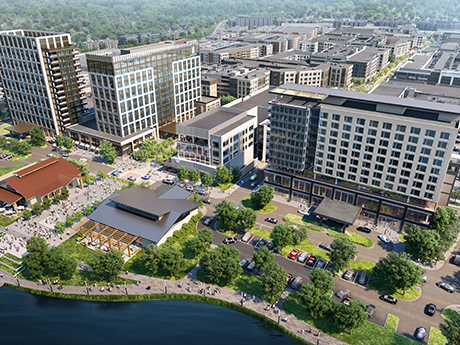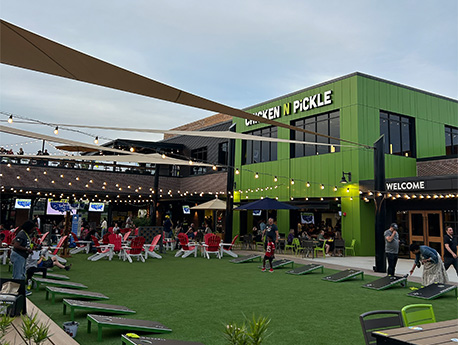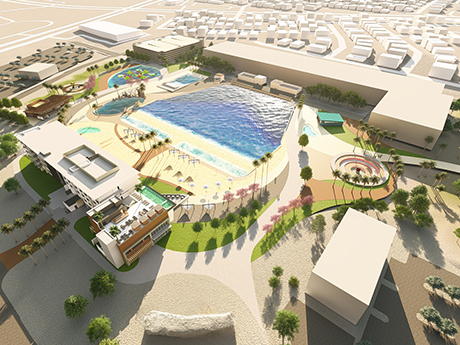By Taylor Williams
In 2016, the Dallas Cowboys went 13-3, finished in first place in the NFC and had five players earn All-Pro selections — arguably the team’s best season-long performance since its heyday in the 1990s.
That’s about all the reminiscing that this writer, who hails from Atlanta, cares to do on the 2016 NFL season. But is it purely coincidental that one of the Cowboys’ most dominant regular-season campaigns in the past three decades coincided with the opening of The Star, the team’s world headquarters and practice facility in Frisco? Perhaps. But for the North Texas region as a whole, the planting of the Cowboys flag outside of city limits marked a sort of coming-out party, a bold declaration that the areas north of the metroplex were primed for major job and population growth, as well as corresponding real estate development.
“When Frisco secured the Dallas Cowboys’ headquarters and The Star District in 2016, it seems to have led to a waterfall of momentum,” says Gloria Salinas, senior vice president and chief growth officer of the Frisco Economic Development Corp. “During that time, Frisco demonstrated an ability to align civic leadership with business priorities, accelerating timelines for that major project and sending a strong signal to the market that the community was ready to continue that approach.”
The answer to the bigger question of when the North Texas boom really began depends on who you ask. There’s no doubt that people, employers and real estate professionals were to some extent already making moves in the region prior to August 2016. After all, buying and assembling the land, securing the permits and approvals and doing the actual construction of The Star didn’t happen overnight. But nearly a decade later, that region has exploded in ways that few could have anticipated back then, emerging as an economic and real estate powerhouse that encapsulates so much more than what’s contained within the Dallas-Fort Worth (DFW) metroplex.
According to the North Texas Commission (NTC), a public-private advocacy organization, the region is currently the fourth-largest metropolitan area in the country, and could soon leapfrog Chicago for the third spot, according to its CEO, Chris Wallace. With a headcount of nearly 9 million people — and growing by the day — across 150 cities and 13 counties, the population of North Texas exceeds that of more than 35 states.
Manufacturing, telecommunications, financial services, leisure/hospitality — not to mention the real estate investments and developments that make them possible — are but a few of the industries that have driven economic diversification throughout North Texas. And Wallace sees that as both a key element of the growth story of the past and a huge selling point of the growth story of the future.
“We’re firing on all cylinders now due to our lower regulatory environment compared to other states that our leadership and legislature have provided,” he says. “We have a diversified economy; a lot of companies want to move and expand here. Our tax system is favorable to other states; we’re able to retain those companies because our economy represents a safe, diversified investment.”
“We also have a growing, skilled labor force that meets the needs of companies when they move or expand here,” Wallace continues. “Ironically, that’s also our biggest challenge — our growth has been so unprecedented that we’re having trouble keeping up with demand in the workforce pipeline, as well as infrastructure and housing attainability and affordability. Those are our top three challenges as a region.”
Andrea Coker, the NTC’s chief advocacy officer, emphasizes the degree to which the growth has been distributed across different municipalities and counties, even as the urban cores of both Dallas and Fort Worth have continued to expand.
“It’s not just reams of people trying to get into our biggest cities,” she says. “Irving-Las Colinas, Plano, Frisco, Richardson — these are also centers of commerce and thriving communities with their own identities and success stories, not just bedroom communities outside of Dallas and Fort Worth. The fact that business and development have been spread across the metroplex instead of concentrated in one or two places creates challenges, but it’s also enhanced companies and people wanting to move to the region.”
Alike, Yet Different
Notwithstanding the incredible impact and power of the Cowboys brand, inherent to the success of The Star was Frisco’s ability to get out ahead of the project and deliver the behind-the-scenes elements needed to make it thrive, Salinas says. Specifically, she credits the community’s early focus on offering high-performing schools, modern roadways and mixed-use real estate zoning in attracting both families and major employers.
The appeal of the city to those groups was again validated shortly thereafter in 2018, when the PGA of America announced the relocation of its corporate headquarters to Frisco from South Florida. The move accounted for hundreds of millions in capital investment, from headquarters facilities to hotels and restaurants to actual golf courses, and the surrounding area now has an obvious golf-based theme underpinning some of its real estate development.
Salinas concedes that these projects, as key components of Frisco’s growth story, mirror those of DFW in terms of the “rapid population gains, business relocations and major infrastructure investments” that they precipitated. But in her view, what’s made Frisco’s story different from that of the big city is the deliberate manner by which it all came to be.
“Our growth has been defined by ‘intentionality,’” Salinas says. “Master-planned communities, best-in-class schools, strategic density, world-class sports/entertainment assets and a pro-business mindset have turned Frisco into a national model for how to scale smartly. This intentional mix ensures that no matter one’s stage in the workforce, there’s a place to call home that is complemented by exceptional amenities, parks, schools and ongoing quality-of-life investments.”

Pictured is a rendering of Fields West, a 55-acre mixed-use project in Frisco by Hunt Realty Investments and The Karahan Cos. The development team recently secured $425 million in construction financing for the project, which will add an array of new retail, restaurant and entertainment uses to a city that has made quality of life one of its defining characteristics.
Intentionality is a concept that other local economic development professionals can also appreciate. Jim Wehmeier, CEO of the Economic Development Corp. of Princeton, located northeast of Dallas, is one such individual.
“When a community starts to grow, to get momentum and some mass, then the goal becomes to be strategic and intentional in creating the community,” he says. “We have [put] an entirely new leadership team in place over the past year or so, and we now have people with 20-plus years of experience, much of which is in rapid growth communities. This makes us well-equipped to steer the growth on a more sustainable, long-term path.”
Fairview, another city located along the northeastern outskirts of Dallas, is investing in its quality of life through an array of projects. One such endeavor is Revolving Kitchen, a 37,000-square-foot food hall that features 34 commercial kitchens, a full-service bar, a dining area and an event space.
“Revolving Kitchen supports emerging food entrepreneurs and is already boosting retail and dining activity in the area,” says “Super” Dave Quinn, Fairview’s economic development manager. “With DFW’s retail vacancy rate at about 5 percent, Revolving Kitchen is helping Fairview cement its reputation as a destination for dining and culinary innovation. The grand opening drew strong community support, and future events like the 2025 Sweet Neighbor Bake-Off will deepen local engagement.”
Then there is Artistic Endeavors, a hands-on creative studio that offers art workshops for children and adults. Quinn says that this concept adds to the growing list of family-friendly experiences in Fairview Town Center, which also features events like live music, youth theater performances and Texas Two Step nights at Accasia’s Event Venue.
“This studio brings in additional foot traffic and supports Fairview’s retail economy by drawing visitors to area anchors like Whole Foods Market and iPic Theaters,” he explains. “It also reinforces Fairview’s appeal to families and creatives, especially as housing demand grows in the region.”
Also within Fairview Town Center is Venture X, a coworking facility that serves startups, freelancers and remote-work professionals with flexible office options.
“Venture X’s presence aligns with changing workforce patterns and supports the local economy by offering scalable business infrastructure,” says Quinn.
In McKinney, located just west of Princeton and north of Fairview, a couple large-scale projects that have recently landed further reflect a pattern of growth that is both reminiscent of trends in DFW, yet also original unto that market. The metroplex has become a magnet for entertainment concepts, both small and large, due to an array of factors, not least of which is the simple fact that going out to shop, dine and game are central to the North Texas leisure and entertainment scene. It’s kind of just what you do in the absence of beaches and mountains.
Enter Cannon Beach, a $200 million hospitality and entertainment development in McKinney that was announced in late 2024. Led by developer Cole Cannon, who has partnered with the city on the project, Cannon Beach will feature a four-acre surf lagoon and resort-style hotel, as well as dining, entertainment and other commercial spaces. The hotel will have a rooftop pool area that can support private events, as well as lounge areas and cabanas with food service. The hotel will also connect to the surf lagoon and other water-focused attractions, including cliff diving and a stationary surf wave. The first phase of Cannon Beach, which is projected to generate as much as $2 billion in regional economic impact over the next 20 years, could open as early as next year.
Somewhat similarly, in nearby Allen, the city council has approved a proposal to develop a 1.2 million-square-foot Kalahari Resort complex that will also feature an outdoor waterpark. Valued at $950 million, the development also calls for a 900-room hotel, convention center and a family entertainment center. The Allen Economic Development Corp., which was unable to participate in this story, estimates that the Kalahari project could create 1,000 jobs and generate $5 billion in economic impact over 10 years.

Chicken N Pickle, a Kansas City-based concept that combines dining with pickleball and other outdoor games, recently opened a 42,000-square-foot restaurant and entertainment venue at The Farm at Allen. North Texas is loaded with entertainment concepts of all kinds that contribute to the high quality of life that helps sustain the region’s population influx.
Michael Kowski, president and CEO of McKinney Economic Development Corp. (MEDC), recognizes that Cannon Beach is not only part of the broader wave of entertainment uses hitting North Texas, but also a truly original concept that distinguishes his market against that backdrop. He cites Cannon Beach and another mega-development, Sunset Amphitheater, a $300 million, 20,000-seat concert venue that the city is developing in partnership with Colorado-based operator Venu, as game-changers in these regards.
“Delivering the Sunset Amphitheater was a major win because it showed the metroplex and nation how McKinney gets big projects done,” Kowski says. “McKinney has long been known as a booming community, and we need industry-redefining projects like these to reinforce our role as a key player in the region. These aren’t just one-off wins. Rather, they are the natural next step of our growing community.”
Kowski adds that both of those projects were made possible by the city’s proactive and prescient land acquisitions.
“Both the concert and waterpark project will rise on land controlled by MEDC; in some cases, we acquired the land 20 years ago and have been waiting for the right partner,” he explains. “The foresight speaks to us trying to get unique entertainment uses for families in McKinney, something our residents consistently ask for.”
Kowski also knows that had the city not bought the sites of Cannon Beach and Sunset Amphitheater when it did, the land would likely have been snapped up by private multifamily developers. Because like the rest of North Texas, McKinney needs all the housing it can get. At the same time, he recognizes the importance of maximizing the city’s return on its land investment.
“A lot of land we’ve purchased over the years would almost certainly have been developed for multifamily, but we knew we needed something that would diversify our tax base through hotel stays, entertainment spends and retail activity,” he says. “Cannon Beach has no residential component, which is a big win for McKinney to have a project in which residential isn’t the driver. This is a clear example of how we can drive value through commercial taxes, not just rooftops.”
Affordability Issues
On the subject of land — not to state the obvious — but the availability of large swaths of undeveloped tracts is perhaps the biggest factor that has allowed many municipalities in North Texas to experience growth that is divergent from the big city.
Master-planned communities with thousands of single- and multifamily homes, as well as commercial districts, dot the landscape of North Texas, even as developers play catch up on delivering the infrastructure needed to make them function. Among those that are in various stages of development are:
• Platinum Ranch, a 2,000-acre community in Gunter by Centurion American
• Landmark by Hillwood, which spans 3,200 acres in Denton
• Preston Harbor, a 3,114-acre lakefront development in Denison by Craig International
• Legacy Hills, a 3,200-acre project in Celina, also by Centurion American
The housing and infrastructure plays within these master-planned developments represent not only direct attempts to provide basic needs, but also indirect efforts to maintain affordability in the region. Like any area that’s experienced explosive growth, North Texas has been subject to diminished affordability, and leaders at both the municipal and regional levels are keenly aware of it.
“There’s no magic formula for housing affordability, and our community grapples with it every year,” says Kowski. “At the same time, rises in home values and equity have allowed many people here to scale up their homeownership and achieve upward mobility. But overall, North Texas is struggling to find that missing middle — diverse homeownership options that are attainable for teachers, healthcare workers and others who keep our economy running. That’s a challenge across North Texas.”
“It’s the million-dollar question — how do you stay affordable while building your community for all levels of income?” concurs Wehmeier. “Simple supply-side economics tells you that demand — rapid growth — is going to drive up prices, and we can’t control that. Land becomes more expensive due to demand, and the literal foundational cost of residential housing goes up. What we can do, and what we have done, is build all levels of housing from starters on up so that in comparison to the rest of this area, we are still very competitive.”
For her part, Salinas sees the affordability issue as an opportunity to reinforce the “intentionality” that has characterized the arc of Frisco’s growth story.
“Frisco’s remarkable growth has been matched by a 70 percent increase in housing units over the past decade, offering residents an incredibly diverse range of options,” she says. “As Frisco grows, so too does our commitment to ensuring affordability and access. In fact, it remains central to the city’s long-term vision.”
“Affordability is becoming more of a concern, but the state legislature has recently begun to recognize and monitor that, not just in rural areas but also in urban areas,” adds Wallace. “There have been some recent initiatives that reflect an attempt to control land use and development of commercial property for residential use. We expect the legislature to continue to monitor housing affordability and for local governments to look harder at that as well.”
“We don’t want that held against us when we’re trying to recruit new companies and people, but we also understand that each municipality is unique and that local control is essential to smart growth,” Wallace concludes. “It’s imperative that we maintain our region’s economic competitiveness, and collaboration among public- and private-sector leaders is a must.”
— This article originally appeared in the July 2025 issue of Texas Real Estate Business magazine.


